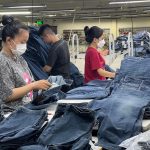Vietnam’s wood industry is witnessing a positive export recovery, with an estimated $9.36 billion in exports during the first seven months of 2024, according to the Ministry of Agriculture and Rural Development. This figure represents a 20.5% increase compared to the same period last year.
Smaller orders, thinner profits
Despite this growth, the global demand remains low, and buyers are cautious about stockpiling. As a result, businesses in the industry are facing challenges such as smaller orders, tighter deadlines, and reduced prices, as shared by Mr. Nguyen Liêm, Chairman of the Binh Duong Wood Processing Association.
The textile industry is experiencing a similar situation, with orders starting to recover in April 2024. VitaJean, a leading jeans company, has seen a 20%-30% increase in orders compared to the previous year. However, Mr. Pham Van Viet, Chairman of VitaJean, points out that political tensions have led to a significant reduction in large orders. The company used to receive orders for up to 50,000 products per code, but now it’s down to 3,000–5,000 products per code. Smaller orders, coupled with increased costs and unchanged prices, have resulted in thinner profit margins.
Mr. Vu Duc Giang, Chairman of the Vietnam Textile and Apparel Association, suggests that local businesses need to focus on technology adoption, human resource development, risk management, and green transformation to turn this challenging situation into an opportunity, especially with Bangladesh facing difficulties.

The wood industry is experiencing a positive export recovery, with many businesses reporting significant increases in orders compared to the previous year. Photo: Thuy Linh
Mr. Pham Xuan Hong, Chairman of Saigon 3 Garment Company and the Ho Chi Minh City Embroidery and Knitting Association, offers a different perspective. He acknowledges the impact of political instability in Bangladesh on the Vietnamese textile industry but believes it is not significant. He attributes this to the focus of Bangladesh’s textile industry on the medium and low-end segments with cheap prices, while Vietnam caters to a higher-end market. Despite the increase in orders, Mr. Hong points out that the industry still faces challenges due to extremely low prices offered by customers and labor shortages faced by some businesses.
Looking ahead, the representative from the Vietnam Textile and Garment Group predicts that demand in key consumer markets is unlikely to improve by the end of the year. Additionally, there is a lack of clarity regarding interest rate reduction plans in major import markets, and competing exporting countries are expected to devalue their currencies by 15%-20% to regain market share. These factors will put pressure on Vietnam’s pricing power, especially considering the already low export prices over the past two years. Other challenges, such as rising sea freight rates, wages, electricity prices, and bank interest rates, further complicate the situation. To navigate these challenges, businesses should focus on producing technically demanding products with high added value, rather than commonplace cheap goods.
Enhancing credit support
Ms. Do Thi Thuy Huong, a member of the Executive Committee of the Vietnam Electronics Business Association, suggests that the solution for businesses lies in approaching suitable-sized orders. Currently, there are many orders that do not require high technology, such as large quantities of small refrigerators for hotels in Sweden and Norway. However, businesses’ readiness to accept these orders is very low, as they seem to be “dreaming” of far-fetched and overly ambitious orders, missing out on the opportunities right in front of them, says Ms. Huong.
She also points out that many businesses choose to work as original equipment manufacturers for big brands, lacking autonomy in the supply chain and design processes. Ms. Huong emphasizes that businesses need to take charge of their designs, master technology, and develop their own branded products to reap higher profits.
Mr. Nguyen Liêm asserts that the market determines the survival of factories, and products dictate the productivity and value of businesses. Therefore, it is crucial for businesses to focus on market development and enhance their governance capabilities to maximize the potential of their factories.
Meanwhile, Mr. Pham Van Viet, Chairman of VitaJean, requests government support in providing preferential loans to help businesses innovate their technology, machinery, and equipment. He highlights that a two-year technological lag can make it impossible to keep up with the world. By embracing technology, businesses can even sell products online to European countries while remaining in Vietnam.
The Ministry of Industry and Trade emphasizes the need for flexible and effective exchange rate and interest rate policies. Specifically, it is crucial to adjust exchange rates flexibly and appropriately in the context of low-interest rates in Europe and Japan and closely monitor the moves of the US Federal Reserve (Fed) to ensure the competitiveness of Vietnamese goods in the international market.
Given the increase in orders and positive signs of export recovery, the Ministry of Industry and Trade has proposed that the Government instruct the State Bank to provide financial support and credit incentives to businesses. This assistance will help businesses fulfill signed contracts and expand exports, particularly in sectors such as textiles, footwear, agriculture, forestry, and aquatic products.
Market diversification
Mr. Do Ngoc Hung, Commercial Counselor and Head of the Vietnam Trade Office in the US, advises businesses to be well-prepared when exporting to the US market, especially considering that the US still considers Vietnam a non-market economy. Businesses should also be aware of the potential for trade remedy lawsuits from US domestic producers at any time.
With Vietnam having signed multiple free trade agreements with major trading partners, Mr. Hung suggests that businesses take advantage of these agreements to diversify their export and import markets for raw materials. This strategy can help avoid trade-related regulations imposed by the US and other World Trade Organization member countries.
T.Linh
Exporting Wood and Textiles: A Promising Sector
Despite experiencing negative growth shock in 2023, Vietnam’s two main export industries have received positive signals at the beginning of 2024.









































